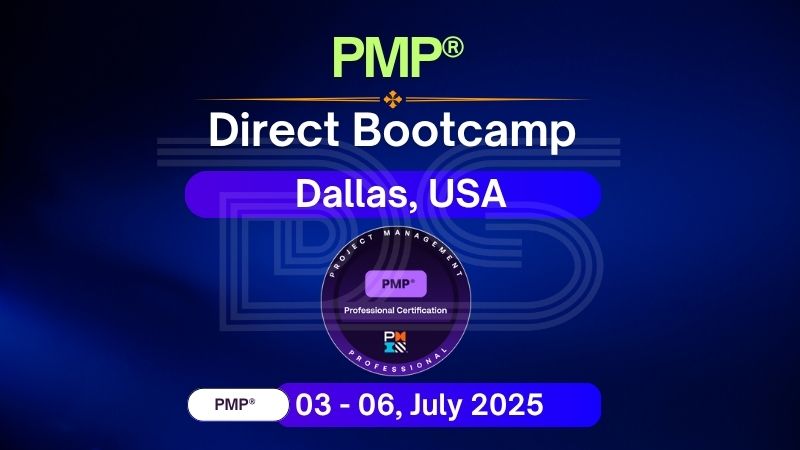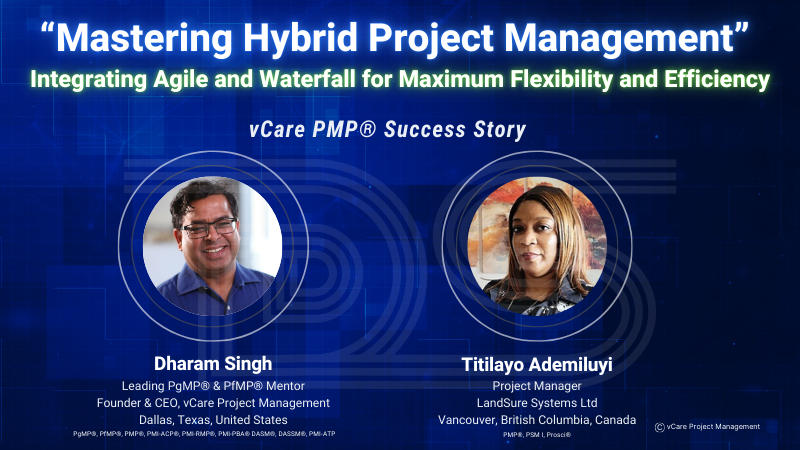
by DharamCW | May 20, 2025 | vCare PMI Certification Training Classes
Excited to announce that I’ll be leading the PMP® Direct Bootcamp in Dallas, USA, this 3rd to 6th July 2025!
If you’re a project management professional looking to get PMP® certified with confidence, this immersive classroom experience is designed just for you.
📅 Date: 3 – 6 July 2025
⏰ Time: 9 AM – 5 PM (CDT)
📍 Location: Dallas, USA
🔗 Register here: https://bit.ly/3WCSuy4
During these four days, I’ll be sharing proven strategies, tools, and tips to help you not only pass the exam but elevate your leadership mindset.
🎓 What’s Included:
✅ Access to PMI Authorized PMP Exam Prep platform
✅ PMP® application and audit assistance
✅ Proven exam strategies & tips
✅ 35 PDUs/Contact Hours
Whether you’re just starting or resuming your PMP® journey, this bootcamp will give you the structure, clarity, and support to succeed.

Level up your PMP journey with Dharam Singh’s in-person PMP Bootcamp in Dallas – July 2025
View our upcoming PMP Programs
Online – https://bit.ly/2BU0mFp
Direct – http://bit.ly/3ic7GRF
Join our PMP4U LinkedIn Group for the latest updates – https://bit.ly/30gV5QX
Explore our useful PMP Study Materials:
vCare PMP Exam Simulator – 1 Year Access: https://bit.ly/41BFc6A
PMBOK Guide | 7th Edition: http://bit.ly/2Z2Zn1b
🎙️ Got questions about your Project Management career or PMI certifications?
Book your FREE 15-min session with me at 👉 www.talktodharam.com
📞 Contact Us
Call: 650-283-0123
Email: [email protected]
🎧 Subscribe & Stay Ahead
Webinars & Success Stories: https://bit.ly/2YF0wJl
Podcasts & Interviews: https://bit.ly/2NDY8wd
Let’s make your certification journey a success — I look forward to seeing you in Dallas!
#PMPBootcamp #ProjectManagement #PMPCertification #PMPDallas #DharamSingh #vCareProjectManagement #PMIATP #PMPMentor #PMPTraining #PMPExamPrep

by Dharam CW2 | Dec 11, 2024 | Professional Development Webinars
Global Strategic Portfolio Leadership | Michael Fritzsche | vCare PgMP & PfMP Success Story
Join me for an exclusive webinar featuring Michael Fritzsche, a distinguished Project Management Professional from Rheinböllen, Rhineland-Palatinate, Germany. Michael, currently the Director of Project Management at HAHN Automation Group, brings over two decades of exceptional leadership and innovation in the automation industry. His career exemplifies excellence in managing global portfolios, driving digital transformation, and fostering organizational resilience.
In this webinar Michael will share his vast expertise and thought leadership on these critical topics:
+ Implementing Effective Governance Models for Global Portfolio Success
+ Managing Risks in Global Portfolios
+ The Role of Technology in Shaping Portfolio Management
+ Best Practices for Handling Portfolio-Level Escalations Globally
+ Adapting Portfolio Strategies for Resilient Growth
+ Future Trends in Portfolio Management
Attendees will gain exclusive career and industry insights, and receive a special discount code for vCare Project Management’s upcoming certification programs.
🔗 Reserve your spot now: https://bit.ly/4fTPF3n
Session Date: Thursday, 19th December 2024
Session Time: 09:00 AM – 10:00 AM (PST) / 10:00 AM – 11:00 AM (MST) / 11:00 AM – 12:00 PM (CST) / 12:00 PM – 01:00 PM (EST) / 02:00 PM – 03:00 PM (BRT) / 05:00 PM – 06:00 PM (GMT) / 06:00 PM – 07:00 PM (CET) / 08:00 PM – 09:00 PM (AST) / 09:00 PM – 10:00 PM (GST) / 10:30 PM – 11:30 PM (IST)
🚀 Elevate Your Project Management Career:
– Book an obligation-free consultation session on Project Management Career, training, and certifications: http://talktodharam.com
– Discover training offers and certification discounts: https://bit.ly/3jWVepD
– Stay updated with our Q&A series and certification success stories by subscribing to the vCare Project Management YouTube channel at https://bit.ly/2YF0wJl
– Follow my podcasts and interviews with Project Management Experts on YouTube at https://bit.ly/2NDY8wd

by DharamCW | Aug 2, 2024 | Professional Development Webinars
Leading Successful Business Transformations – Best Practices and Lessons Learned | Cheryl Bowen | vCare PgMP Success Story
Join us for an insightful webinar hosted by vCare Project Management, featuring the distinguished Cheryl Bowen, a seasoned Program and Project Management professional with over 18 years of experience in the Reinsurance industry from Ocoee, Florida, United States. Cheryl, the Principal Project Manager at Hannover Re in Germany, is known for her exceptional skills in driving complex financial system conversions and overseeing large-scale program management initiatives.
Session discussion topics include the following:
+ Ensuring High Levels of Engagement and Buy-In from Stakeholders during Transformation Projects
+ Conducting Post-Mortem Reviews after Transformation Projects
+ Ensuring Sustainability of Transformation Initiatives
+ Rethinking Business Models for Successful Transformation
+ Ensuring Effective Leadership and Team Support during Transformational Changes
Attendees will benefit from Cheryl Bowen’s expertise, earn 1 PDU, and gain valuable industry, career, and certification insights. This knowledge will empower you to navigate the complexities of project management. Additionally, attendees will receive a special discount code on our upcoming PMP, PgMP, and PfMP programs.
🔗 Reserve your spot now: https://bit.ly/3Lpjifb
Session Date: Thursday, 29th August, 2024
Session Time: 10:00 AM – 11:00 AM (PDT) / 11:00 AM – 12:00 PM (MDT) / 12:00 PM – 01:00 PM (CDT) / 01:00 PM – 02:00 PM (EDT) / 02:00 PM – 03:00 PM (BRT) / 06:00 PM – 07:00 PM (BST) / 07:00 PM – 08:00 PM (CEST) / 08:00 PM – 09:00 PM (AST) / 09:00 PM – 10:00 PM (GST) / 10:30 PM – 11:30 PM (IST)
🚀 Elevate Your Project Management Career:
– Book an obligation-free consultation session on Project Management Career, training, and certifications: http://talktodharam.com
– Discover training offers and certification discounts: https://bit.ly/3jWVepD
– Stay updated with our Q&A series and certification success stories by subscribing to the vCare Project Management YouTube channel at https://bit.ly/2YF0wJl
– Follow my podcasts and interviews with Project Management Experts on YouTube at https://bit.ly/2NDY8wd
#BusinessTransformation #ProjectLeadership #PgMPWebinar #Ocoee #Florida #USA #Germany #PMP #PgMP #PfMP #ProjectManagement #StakeholderEngagement #ProgramManagement #ChangeManagement #TransformationProjects #FinancialSystems #PostMortemReviews #SustainableChange #BusinessModels #TeamSupport #ProfessionalDevelopment #IndustryInsights #CareerGrowth #PgMPCertification #PgMPExam #PgMPCourse #PgMPTraining #AskDharam #DharamSingh #DharamSinghPgMP #DharamSinghPfMP #DharamSinghPMP #VCareProjectManagement #ProgramManagementProfessional #ProjectManagementProfessional

by DharamCW | Jun 11, 2024 | Professional Development Webinars

by DharamCW | Feb 19, 2024 | Program Management
Problem-Solving and Decision-Making in Program Portfolio Management | Justin Buckwalter | Episode 12
In a world where uncertainty is the only certainty, Problem Solving and Decision Making have never been more crucial for Program Management and Portfolio Management professionals. Join me for a stimulating discussion with Justin Buckwalter, PfMP, PgMP, PMP, PMI-ACP, PMI-RMP on Episode 12 of our series, exploring the frontiers of decision-making in the VUCA environment.
🔍 Episode Highlights:
– Does the adage ‘Too many cooks spoil the broth’ hold in project decision-making? We invite you to weigh in with your experiences.
– Uncover how Artificial Intelligence is reshaping our approach as Problem Solvers in the realm of program/portfolio management.
– Dive into strategies for navigating through economic uncertainty and making swift project decisions.
– Discuss overcoming behavioral biases and harnessing the power of Change Management and Risk Mitigation in sensitive projects.
👨💼 As Project Leaders, we must evolve, adapt, and often recover from decision-making mishaps. How do you pivot and keep the momentum going?
For a deep dive into these critical competencies that define the success of modern program/portfolio managers, tune into our conversation.
🚀 Elevate Your Project Management Career:
– Register for my upcoming PgMP/PfMP Success Story Webinar: https://bit.ly/3S53K3a
– Book an obligation-free consultation session on Project management Career, training, and certifications: http://talktodharam.com/
– Discover training offers and certification discounts: https://bit.ly/3jWVepD
– Stay updated with our Q&A series and certification success stories by subscribing to the vCare Project Management YouTube channel at https://bit.ly/2YF0wJl
– Follow my podcasts and interviews with Project Management Experts on YouTube at https://bit.ly/2NDY8wd











Join me for an exclusive webinar with Titilayo Ademiluyi , a distinguished Project Manager at LandSure Systems Ltd in Vancouver, Canada. With over two decades of extensive experience in project and program management, Titilayo is a respected leader in the industry. Her expertise in hybrid project management approaches and driving successful project outcomes makes her the perfect keynote speaker for this session.
This webinar will cover, among many, the below topics:
+ The Importance of Tailored Approaches in Hybrid Project Management
+ Advantages and Challenges of Merging Agile and Waterfall
+ Case Studies: Large-Scale Transformation Projects Using Hybrid Approaches
+ Managing Stakeholder Expectations and Change in Hybrid Projects
+ Identifying and Mitigating Scope Creep and Risk in Hybrid Projects
+ Overcoming Data Migration and Integration Challenges
+ Measuring Success in Hybrid Projects
🔗 Reserve your spot now: https://bit.ly/3Kg4waj
Session Date: Thursday, 27th June, 2024
Attendees will benefit from Titilayo Ademiluyi’s extensive experience, earn 1 PDU, and gain valuable insights into industry trends, career development, and certification strategies. Attendees will also receive a special discount code on our upcoming PMP, PgMP, and PfMP programs.